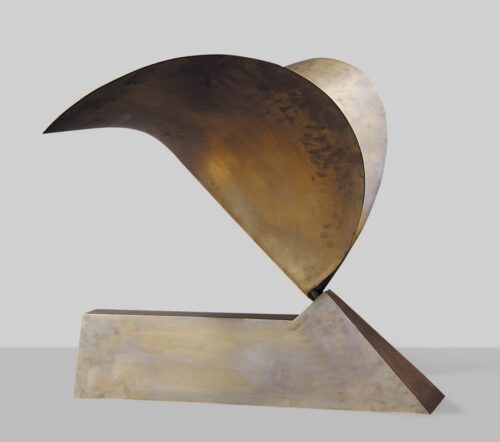
Calatrava Santiago (1951)
Bird, 2000
At the age of eight, he enrolled in the Valencia Arts and Crafts School, where he received his first drawing and painting lessons. After completing his secondary education, he enrolled in 1968 in the Valencia School of Fine Arts, in which he studied until 1969. In 1969-1974, he studied Architecture at the Superior Technical School of Architecture in Valencia and went on to postgraduate studies in Urban Planning. He then received his degree in Civil Engineering from the Swiss Federal Institute of Technology (ETH) in Zurich (1975-1979), followed by a Ph.D. in Technical Sciences at the ETH Department of Architecture (1979-1981). In 1981, he established his first office in Zurich. In 1989, he established an office in Paris and in 1991 in Valencia.
He has received a great number of awards and medals, including the Artists’ Award of the City of Barcelona for the Bach-de-Roda Bridge (1988), the Silver Medal for Research and Technique of the Fondation Academie d’Architecture (1970), the Gold Medal of the London Institute of Structural Engineers (1992), the Gold Medal for Distinction in Fine Arts by the Spanish Ministry of Culture (1996), as well as the Exitos 2000 Award for his Valencia Museum of Sciences (2001). He is a fellow in several universities in Europe and the United States as well as member of many organisations, including the International Architecture Academy (1987), the Royal Institute of British Architects (1993) and the Royal Swedish Academy of Engineering Sciences (1999).
With wide-ranging interests (architecture, sculpture and design) and drawing inspiration from numerous sources (sculptor Konstantin Brancusi, architect Antonio Gaudi, Gothic art, and above all nature), Santiago Calatrava produces works of imposing aesthetic qualities, which blend harmoniously with their surroundings. Starting from drawing and sculpture, he creates forms which evolve into architectural structures – bridges, airports, railway stations, museums, opera houses – and whose extraordinary, minimal style echoes organic forms. Never opting for functionalism at the expense of aesthetics, and with evident awareness of the construction media, he designs buildings of dynamic forms, distinguished for their harmony and lightness.

Bird, 2000

We use cookies to make our site work properly, to personalize content and ads, to provide social media features and to analyze our traffic. We also share information about how you use our site with our social media, advertising and analytics partners. Read the Cookies Policy.
These cookies are necessary for the website to function and cannot be switched off in our systems. They are usually only set in response to actions made by you which amount to a request for services, such as setting your privacy preferences, logging in or filling in forms. You can set your browser to block or alert you about these cookies, but some parts of the site will not then work. These cookies do not store any personally identifiable information.
If you disable this cookie, we will not be able to save your preferences. This means that every time you visit this website you will need to enable or disable cookies again.
These cookies tell us about how you use the site and they help us to make it better. For example these cookies count the number of visitors to our website and see how visitors move around when they are using it. This helps us to improve the way our site works, for example, by ensuring that users find what they are looking for easily. Our website uses Google Analytics for statistics reporting.
Please enable Strictly Necessary Cookies first so that we can save your preferences!